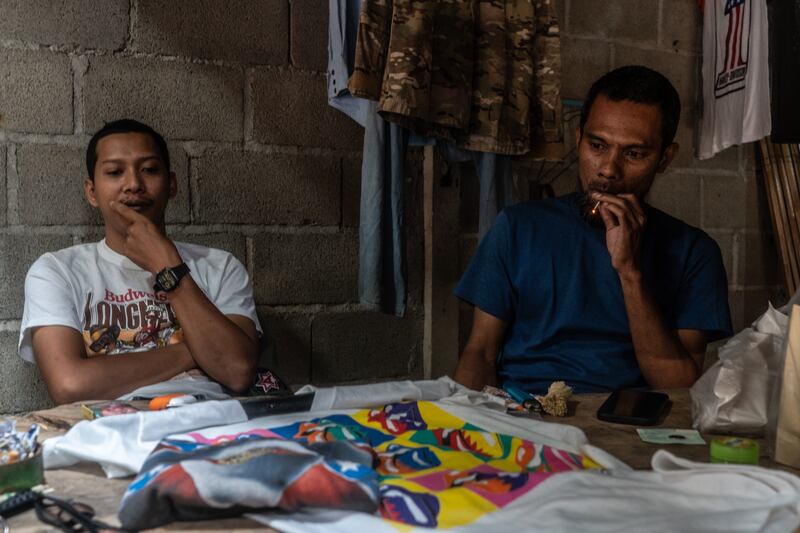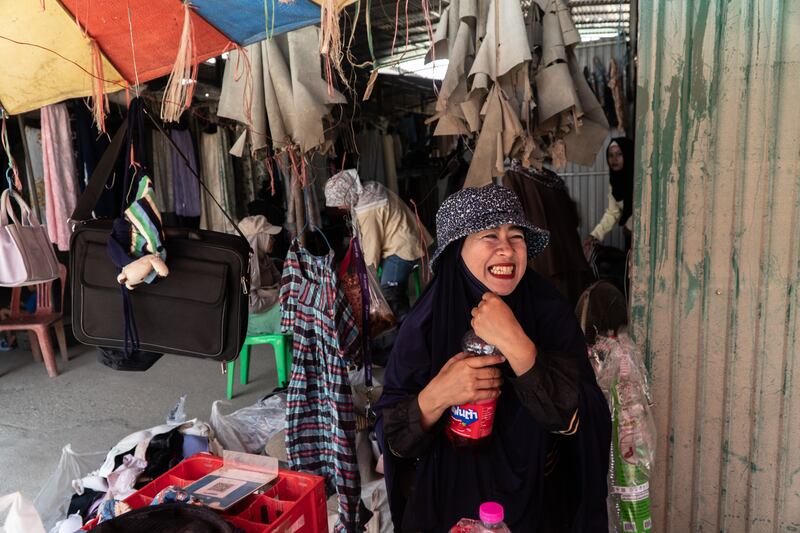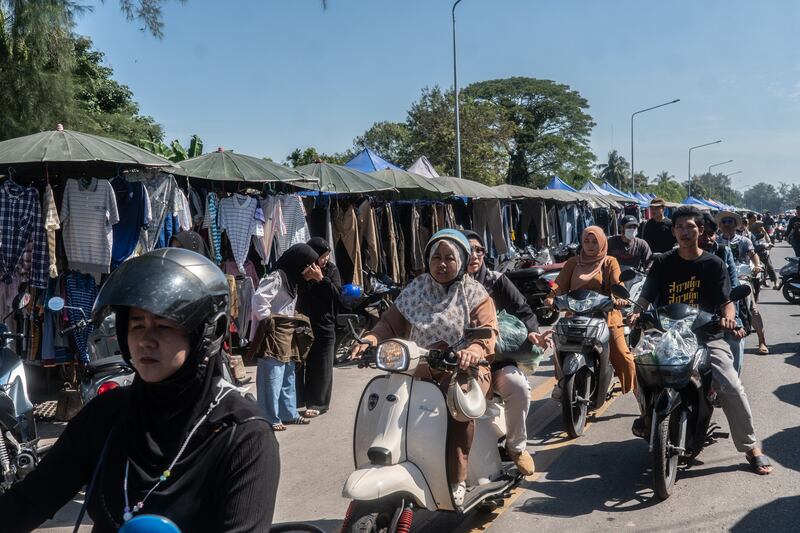Piya Dueramae makes a living selling secondhand clothes, and spends much of his time hunting for rare finds in markets across Thailand’s Deep South.
The 43-year-old’s connection to the business runs deep – his parents introduced secondhand markets to him when was a child.
“In Yala, we grew up going to the Maprao Market for clothes,” Piya told BenarNews, referring to a popular used-clothes market in Yala province.
“While city kids shopped in malls, our parents took us to secondhand markets. It became a way of life, a culture.”
Used clothes shipped in from the United States – such as blue jeans and t-shirts featuring Marvel Comics’ action heroes – are among the “treasures” that can be found among piles of old apparel at secondhand markets in the Deep South.
The mainly Malay Muslim border region is more known for a long-running separatist insurgency than its booming secondhand clothing market. But used clothing is deeply ingrained in the local culture.
By buying secondhand clothes, people with low incomes in this economically underdeveloped region could afford popular brand name apparel. The secondhand markets in southern Thailand grew bigger with the global trend of vintage clothing gaining popularity, as these markets became well-known for the rare items they sold.
“The beginning of second-hand clothing sales in the southern border areas started in 1973, when villagers from Yaring district, Pattani, who worked on fishing boats in Malaysia, brought second-hand clothes and goods from Malaysia back to sell at home,” Thitaree Srisurat, editor of the Rusamilae Journal at Prince of Songkla University in Pattani, another province in the Deep South, wrote in a 2021 article.
“It gained popularity, and many families took it up as a business, with about 20% of the community working in second-hand clothing sales. Some families still continue this to this day.”
The main factor is affordability.
“People here cannot afford expensive goods, and since these are second-hand clothes, they don’t feel bad about wearing them to work in the fields,” Thitaree said.
Soliha Ayohsae, a veteran secondhand clothing vendor, switched from running a regular clothing store in Bangkok to selling used clothes in southern Thailand because of the higher demand in the region.
“It’s easier and faster to sell here than in Bangkok because it’s cheaper. I used to sell in Bangkok, and although the profit per item was higher, the sales were fewer. Here, people buy a lot and often. Since it’s second-hand, they can easily replace it without feeling guilty,” Soliha told BenarNews.
“People here prefer secondhand because they are branded, high-quality, and affordable…. The demand has always been strong.”

The secondhand fashion industry has witnessed explosive growth worldwide.
According to ThredUp, a United States-based resale marketplace, secondhand clothes’ share of the total global apparel in 2025 is expected to be 10%, or U.S. $246 billion.
This used clothes market is projected to grow at an annual rate of 12% between 2024 and 2027, reaching an estimated value of $350 billion by 2027, with Asia expected to account for 41%.
Thailand’s secondhand market is expanding alongside.
The Thai secondhand fashion market in 2023 was valued at 1.8 billion baht ($53.4 million), reflecting a 20% growth from the previous year, according to a report by SCB Economic Intelligence Center.
It is expected to continue growing at a rate of 15% annually through 2027. However, no studies have specifically examined the market in Thailand’s Deep South, where buying used clothes has been the norm for decades.
Data for 2024 was not available.
Secondhand clothing in southern Thailand is mostly available in key markets like Yala’s
Maprao Market, and Pattani’s Rusamilae and Yaring markets. A diverse clientele shops at these places including locals and collectors, seeking vintage American apparel, such as blue jeans.
‘Discarded in America but are treasures here’
Most of the secondhand clothing available in Thailand comes from the U.S. via Malaysia. The clothing is transported from America to Malaysia via cargo ships.
Foreign vendors in Thailand then purchase some of these clothes to resell in their countries.
Soliha, the veteran secondhand clothing seller from Maprao Market, said secondhand American apparel was in high demand.
“These were once discarded in America but are treasures here. People buy them for work, farming, the office, and even as fashion. The quality is good, the price is low, and vintage never goes out of style,” she said.
“Maprao Market is a shopping paradise. We get shoppers from Malaysia’s border areas, Pakistan, and Western tourists also shop here. I make over 100,000 baht [$2,966] a month.”
A single bale of secondhand clothing imported from Malaysia, which could consist of 200-220 T-shirts or 150-180 jackets or trousers, costs around 1,000 baht ($29.6).
At Maprao Market these clothes could then sell for anything from 5 baht (U.S. 14 cents) an item to tens of thousands of baht per item, depending on their rarity and brand.

The popularity of secondhand clothing has led to eye-catching sale prices at auctions.
For instance, a vintage (1997) T-shirt featuring Marvel Comics’ characters Spider-Man, Daredevil, and Silver Surfer from Maprao Market sold for 220,000 baht ($6,526) in an online auction.
“Collectors from Japan, in particular, love U.S. made T-shirts, especially ones made of thin cotton fabrics, and [music] band T-shirts,” he said.
Piya, the Yala vendor, said he bought a vintage T-shirt from the 1970s from Maprao Market for 80 baht ($2.37) and sold it for 22,000 baht ($654) in the same market.
Secondhand military apparel, workwear, denim, jerseys and Hawaiian shirts also fetch high prices. Military garments from World War II, and the Korean and Vietnam wars are considered especially valuable, particularly if they feature unit-specific prints.
Lately, unofficial band merchandise, which is usually sold outside concert venues, is becoming trendy as well.
“Some of these items sell for over 100,000 baht ($2,800) each, more than what official band merchandise sells for,” Piya said.
“You have to know what’s valuable and what’s not.”

Competition is rising, though, with a growth in demand.
Some vendors buy high-value pieces from southern markers to resell them in Bangkok. More are being filtered before they reach Thailand, as the popularity of vintage clothing has risen. And more Japanese collectors too are traveling to Thailand to hand-pick rare finds.
As demand grows, sellers must continuously expand their knowledge to remain competitive in an increasingly globalized market, vendors said.
For vendors in southern Thailand secondhand clothing is about more than just fashion or a hobby – it’s a livelihood.
“This business is not just a passion anymore; it supports our families and our children’s education,” Piya said.
“We have to adapt. The secondhand market is changing fast, and only those who learn and evolve will survive.”
